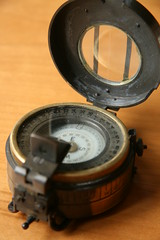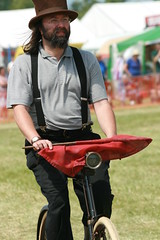I got this from a flea market in Paris about ten years ago. I told myself that it was to help me find my way walking along the Paris meridian. Really I just liked the look of it.
When I moved back to the UK it went missing, and I assumed it was lost for good. But we have been taking a load of boxes out of the loft for sorting, and it has turned up again, along with a lot of other bits and bobs.
On the back it says "Stanley London, 1935". There is a folding prism on the side, which is obviously for taking bearings, but until this afternoon I hadn't managed to figure out how to use it.
A lost compass was never much help, and I don't suppose a found one is going to get a lot of use either. But it's nice to have it back.
Friday, 24 June 2011
Monday, 13 June 2011
Under construction
This is part of the original Bartholomew's revised "half-inch" contoured map of Herts and Bucks. We found it in a second-hand bookshop a few days ago. The history on the back cover says:
These maps didn't carry a date, but judging by the text on the cover ("By appointment to the Late King George V"), it has to date from later than 1936, and as it shows the railway line from Bourne End to High Wycombe, it presumably dates from before 1970, when that line closed.
I've also been looking at details of various Bartholomew design changes here. As far as I can make out from the index of sheets it was based on a layout that was used from 1940 onwards, and the cover design seems to date from before 1963. Judging by the original cover price (2/6), it dates from the early 1950's. However, it shows the Maidenhead bypass as being under construction. That became the first section of the M4 in 1963. So perhaps it actually dates from nearer then.
These days, of course, a fifty-year-old map is of no practical use whatsoever, but it is a thing of beauty nevertheless.
"This map has unique record among cartographical publications. The first sheets were brought out in 1875 with simple colouring by counties. At the Paris Exhibition of 1878 Mr Bartholomew showed specimen sheets printed in layer or contour colouring. That system was eventually adopted for the whole publication, which thus became the first topographical series in any country to use it. Based originally on the Ordnance Survey, by permission, it is now kept up to date by its own service of information and is generally acknowledged the most up-to-date of any map in the country".
I've also been looking at details of various Bartholomew design changes here. As far as I can make out from the index of sheets it was based on a layout that was used from 1940 onwards, and the cover design seems to date from before 1963. Judging by the original cover price (2/6), it dates from the early 1950's. However, it shows the Maidenhead bypass as being under construction. That became the first section of the M4 in 1963. So perhaps it actually dates from nearer then.
Beneath the map is this note:
"The publishers record their appreciation of the valuable services rendered in th past by map users un assisting to maintain the accuracy of this series and are always pleased to acknowledge any corrections brought to their notice".
I guess it's probably too late to let them know about Beeching, the construction of the M4 and M40, or that there are no longer Youth Hostels in Maidenhead, Henley, Beaconsfield / Chalfont St Peter, and Lane End. Instead (if only there was an agreed tagging scheme) we could all be out there adding abandoned Youth Hostels to OSM.
These days, of course, a fifty-year-old map is of no practical use whatsoever, but it is a thing of beauty nevertheless.
Friday, 10 June 2011
Sunday, 5 June 2011
A modest proposal
As to the number of persons in charge of a locomotive propelled by steam, or any other than animal power to be used on any public highway. It shall not be lawful for any owner of such locomotive, either in his own person or by his servants, to use any such locomotive, wagon, or carriage on the turnpike or other roads, except there be at the least three persons to drive or conduct such locomotive: one to steer, one to stoke, and one to proceed sixty yards ahead with a red flag to alert those in control of horses of the imminent approach of the vehicle.
Wednesday, 1 June 2011
Elliot 803
This is a video of an Elliott 803 computer. It's the first machine I ever wrote a programme for. The whole thing was the size of a room. The only input and output devices used five-column paper tape.
We prepared our programmes on teletype machines. Then we used little switches on the console to boot the machine with the Algol compiler, and read our programmes in. I remember them as toggle switches, but they seem to be buttons here, so I must have got that muddled.
After a while the machine punched out another reel of paper tape containing the executable programme that it had generated. We rebooted again with the little switches to load the executable, and waited for the results.
My most successful programme generated solution to "Seven Bridges of Königsberg" type of problems, which it output as yet another reel of paper tape. That went into a pen plotter for the final result. It's (more or less) a standard routing problem, and the algorithm I used was pretty crude, but I was very proud of it at the time. Somewhere I think I still have the listing and paper tape, but years ago when I took another look at it I realised that there was a bug that my test cases hadn't picked up. I was gutted.
This must have been in the late 60's. I was still at school, and immensely lucky in those days and at that age, to have access to this technology. Happy memories, but things have moved on a little since then. It's amazing how evocative the various sounds are.
I hadn't realised that they had one working at the National Museum of Computing in Bletchley Park. I must plan a visit.
I hadn't realised that they had one working at the National Museum of Computing in Bletchley Park. I must plan a visit.
Subscribe to:
Posts (Atom)


